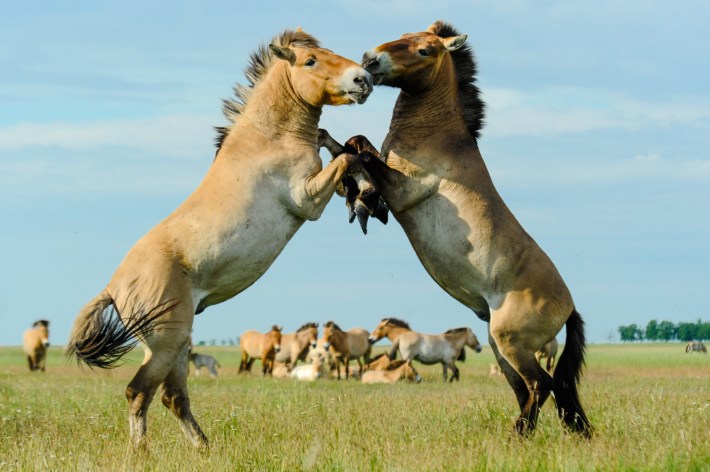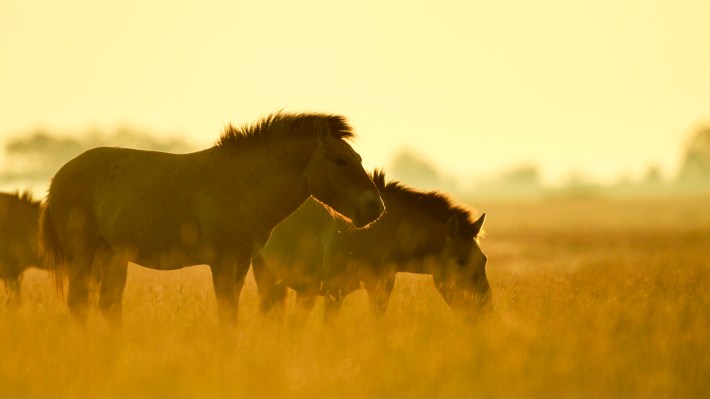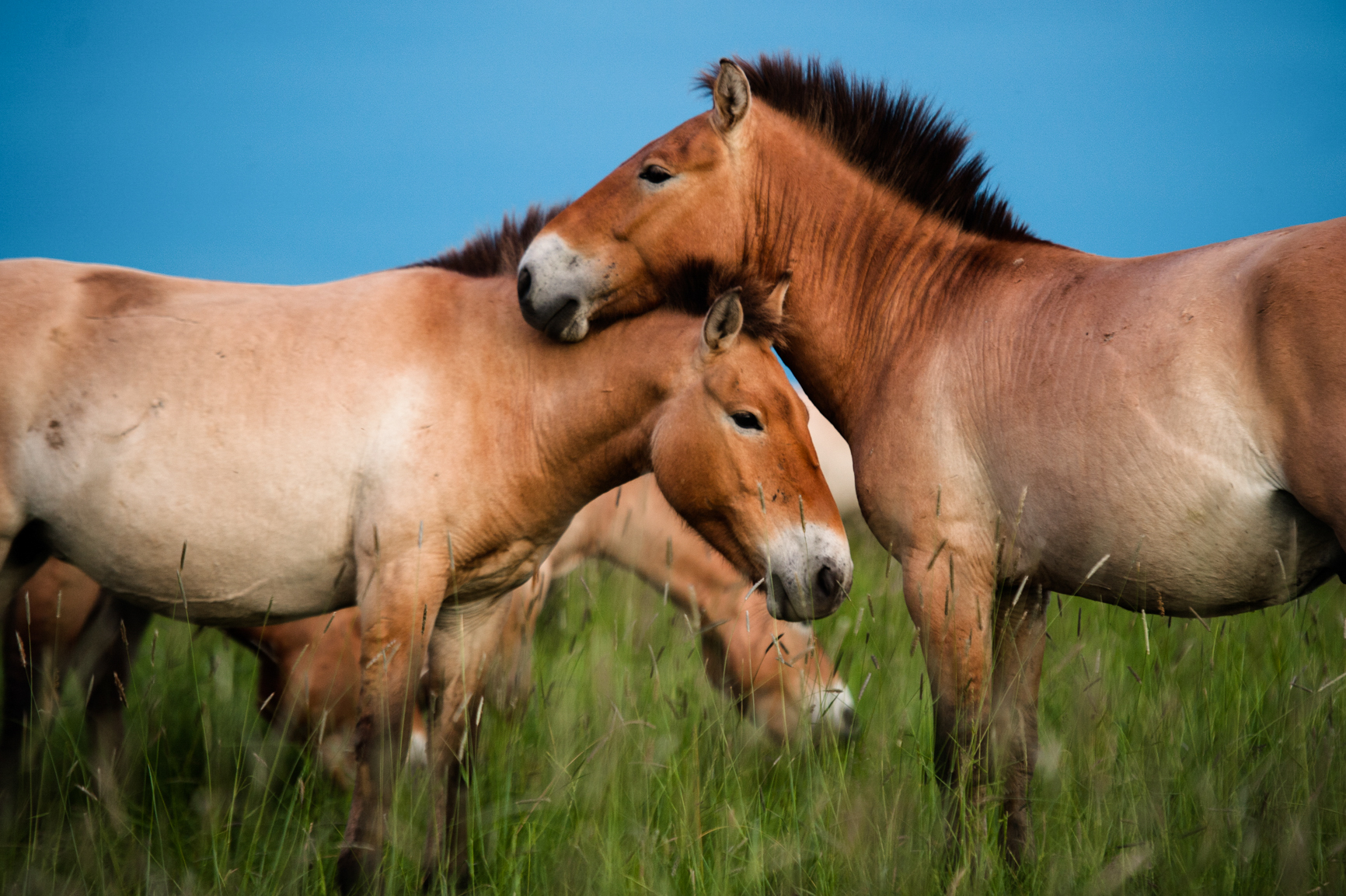In the grassy plains of Hortobágy, Hungary's first national park, Przewalski’s horses roam in one majestic herd. They are squat little horses, with big heads and stubby, punkish manes. They are not the wild horses that roam the American West, which are technically feral, descended from domestic horses that escaped captivity or were released back into the wild. Rather, Przewalski’s horses (pronounced shuh-VAL-skee) are the last living subspecies of Equus ferus. They have never been tamed and are considered the only true wild horses left in the world.
In the 20th century, Przewalski’s horses were thought to be extinct in the wild. But in 1996, scientists discovered a single mature horse and began a captive breeding program, eventually reintroducing the horses in the wild in parts of Asia and Europe. All Przewalski’s horses living today are descended from 12 wild-caught horses and a handful of domestic horses. In 1997, a herd of Przewalski’s horses were released in Hortobágy, where they live in an enclosure of more than 11 square miles of steppe and wetlands. Researchers have tracked these horses over 23 years, offering a valuable window into the goings-on of Hortobágy's horse society, a complex system defined by harems of horses. Now, a new paper published in the journal Nature Communications uses drone footage to dive deeper into the relationships that scaffold this equine social network.
We live in a society, and so do horses. For Przewalski’s horses, feral horses, and zebras, society is defined by harems, groups that consist of one stallion, a group of mares, and their young offspring. Harems offer Przewalski’s horses a cushy, elite kind of lifestyle. The stallion, a male horse between 6 and 15 years old, guards his mares and their offspring from predators and harassment from other horses, often ensuring they are in better health and have a better chance at reproducing. The stallions have to be strong to acquire mares for his harem and protect them from other stallions, but it's an obvious trade for reproductive access to a gaggle of mares (horse-wives, if you will).

Of course, not all Przewalski’s horses can be in harems. The remaining male horses live in groups of bachelors, comprising young male horses and former stallions who have lost their harems. As their name definitely suggests, the bachelor horses do not breed. And, as their name might suggest, they would love to. So stallions must defend their harems from the roving bachelors and risk being usurped—an ongoing power struggle that holds the promise of excellent reality TV.
Although Hortobágy's horses are technically captive, enclosed by a fence, they live otherwise independent lives. They are not fed, watered, or medically treated, and they form their social structure according to their own devices, according to a 2021 paper published in the journal Global Ecology and Conservation. Although harems of wild Przewalski’s horses in central Mongolia live apart from each other in home ranges, in Hortobágy the horses roam as one enormous multilevel herd of more than 270 horses, the structure of which can be difficult to assess without disturbing the animals.
The researchers filmed the giant herd using drones, capturing five-minute videos of the herd moving throughout the reserve on five different days. They analyzed the footage to identify individual horses in each harem, track their location within the herd on different days, and better understand how the horses took their positions within the larger herd. Zooming in on the drone footage allowed the researchers to identify particular horses, such as Valentina, Jos, Tobias, Zselyke, Rosalinde, and Rendetlen grazing in picturesque grasslands. The researchers found older and larger harems, which were led by older and more experienced stallions, occupy central locations in the social network of the herd.
Since the Hortobágy herd was established in 1997, the harems have multiplied and experienced huge shifts over time. One harem, initially led by stallion Elod in 2006, quickly fell to stallion Ekes in 2008, stallion Fako in 2010, stallion Kanya in 2015, and finally stallion Fsoos in 2019. Fsoos is one of Hortobágy's most productive stallions, siring more offspring than any other male horse in the reserve—perhaps aided by the fact that his harem merged with another harem, formerly led by stallion Fergeteg, around 2014. Fsoos kept all the mares, while Fergeteg was left with no mares.

The heart of Hortobágy's horse culture is not only with stallions, but also with the mares. Societies of humans and other primates are often drive by male-male bonds, the researchers write. But in this population of Przewalski’s horses harem aggregations are also driven by friendship relationships between mares. Related mares tended not to be harem mates, a practice that increases the genetic diversity of the herd. But non-related females grow closer to each other the longer they stay in the same harem.
The mares can also decide to leave their harem, and often closely affiliated females will defect to a different harem together. The researchers found their drone observations of each horse's movement within the herd could help predict the mares' future harem choice; mares living in different harems that would later join the same harem were already moving quite similarly within the herd. In other words, filming the female's behavior revealed the groundwork set for future harem-swapping drama. Reality TV is good!
What will happen next week on The Real Horse-Wives Of Hortobágy? Could Rosalinde and Rendetlen's closeness hint at a future harem swap? Are Rona and Ofelia getting a villain edit? Who will succeed Fsoos as the most popular horse-father, and could it be his son Nemo, already a father of his own? What kind of grass is Valentina eating? Find out next week!






